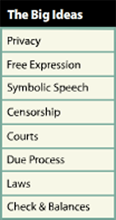The Big Ideas menu bar > Due Process
What is Due Process?
The What Is Due Process? module explores the meaning and purpose of due process. It is accomplished through a story inside a story. The opening story concerns kids coming home from a concert after curfew. As it turns out, the curfew storyline is really a movie. When the director (who is Justice) yells “cut,” one of the actors says that he really does not understand what’s going on. Using movies, Justice explains due process.
What Judges Do
The What Judges Do module opens with a terrible, horrible, rotten, no-good day in which everything goes wrong and everyone wants justice! The storyline describes the types of conflict that courts help resolve and the role of the judges in applying the law to the facts of each case. A section on judicial independence describes how fair and even application of law requires that judges be able to rule on cases without retaliation from politicians or the public.
What Courts Do
The What Courts Do module explores the purposes for courts. It begins with a story about an immigrant about to go to court and worried about what might happen. Justice reassures him that everything will be fine while explaining the purpose of courts.
Civil Cases
The Civil Cases module explores how courts resolve conflict and covers both torts and contracts as examples of civil cases. The module also illustrates civil trials through a story about a juggler who loses control of his clubs and injures a passerby.
> more
|


